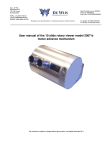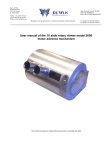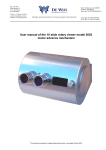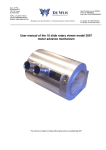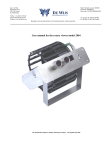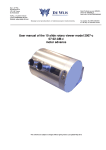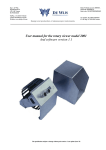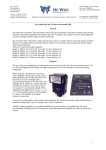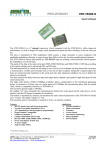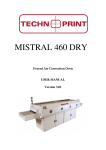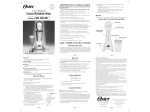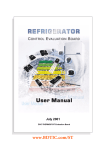Download 03-02 Manual for hand wheel model
Transcript
Ing. J. de Wijs. Populierstraat 44, 4131 AR Vianen, the Netherlands Bank: Postbank account: 6084601, Swiftcode: INGBNL2A Bank code: NL24PSTB0006084601 Tel/Fax. +31 (0)347-372242 e-mail: [email protected] Website: www.dewijs-3d.com Design and production of stereoscopic instruments. Tax number: NL 1899.16.084 B01 K.v.K. Reg. Nº 23071201 Utrecht User manual of the 10 slide rotary viewer model 2003 manual advance mechanism The contents are subject to changes without giving notice. Last update October 2004 Contents INTRODUCTION ................................................................................... 3 1. FIRST INDICATIONS FOR OPERATIONAL USE .......................... 4 1.1 OPENING THE VIEWER FOR EXCHANGING THE SLIDES. ............................................ 4 1.2 WERE DO I PLACE THE VIEWER?............................................................................ 5 1.3 HOW DO I MOUNT THE VIEWER AGAINST A WALL? ................................................. 5 2. MANUAL OPERATION (WITHOUT PC CONTROL)...................... 6 2.1 TWO OPERATIONAL MODES: .................................................................................. 6 4. EXTERNAL CONTROL (WITH PC) .................................................. 7 4.1 SETTING UP THE EQUIPMENT AND CABLE CONNECTIONS ......................................... 7 6 DATA ...................................................................................................... 8 6.1 TECHNICAL SPECIFICATIONS OF THE ROTARY VIEWER ............................................ 8 6.2 INTERNAL CONNECTION DIAGRAM ......................................................................... 9 6.3 CONNECTIONS OF THE D25 AND J3 CONNECTOR.................................................. 10 6.4 ELECTRONIC COMPONENT LIST MODEL 03-02-A-H .............................................. 11 Introduction This viewer is the result 30 years of experience in building high quality 3D slide viewers for public use. Each change in the previous models extended the durability, stability and the quality. Especially this 10-slide rotary viewer 2003 has been adapted for the demand to show short 3D slide series to large amounts of public to be informed. To give any idea about the changes with respect to the previous model: - The slide drum is available in the motor driven as well as the hand-operated version. - The viewer can be mounted against a wall and it does not need any cover or housing to hold the mechanical parts. - The new CCFL lamp provides a bright cool white light source without any start-up flickering. - This viewer is also suited with an automatic return to slide Nº 1 in the motor driven version. - External control by means of a Personal Computer is possible. - A simple 12 Volts dc adapter provides a safe power source. 1. First indications for operational use 1.1 Opening the viewer for exchanging the slides. - For exchanging the slides you have to remove the left cover of the round housing; see the image. That is NOT the side where the text window and the pushbutton are located. - Remove the 6 bolts and remove the cover (picture 1) Picture 1 Picture 2 - Now you see the round slide drum with a large nut in the middle, take a bolt spanner, hold the drum with your hand and remove the nut (picture 2). - Put your hands around the drum and push with your thumb on the spindle to draw the drum from the spindle out of the viewer (picture 3). Picture 4 - Picture 3 Picture 5 Now you can insert or exchange your slides. Keep the order and position of the slides in mind that they won’t be presented up side down! (Picture 4 and 5) After exchanging the slides you can replace the slide drum in the viewer. Be careful with inserting. Replace the nut on the spindle using the spanner and replace the cover. 4 1.2 Were do I place the viewer? Obviously you already have chosen a spot for the viewer in your museum, exhibition or other public environment. Here are some considerations that might help you to check the spot; ? ? Keep in mind the height of the viewer. Children and grown-ups both want to look in the viewer! ? ? Depending on the interest of the viewer, people might form a queue. This could cause congestion for the rest of the public. ? ? Watch out for sunlight coming through the lenses! The lenses will act like burn glasses on the slides. A few minutes in the sun will cause enough damage to the slide that it should be replaced. Within 1 day, in worst case, you have to replace all slides. You can see this on the slide like tiny little white spots showing the track of the sun during the day. ? ? Avoid spotlights to be shinning on the lenses. The slides are not going to be burned but it does shorten the lifecycle of the slide. ? ? When the viewer is to be mounted inside some kind of panel, be sure you can get easy access to the viewer for replacing the slides. 1.3 How do I mount the viewer against a wall? The 10 slide rotary viewer holds a bracket at the back that has several holes to attach the viewer with screws or bolts against a wall. First you have to remove the 3 bolts on the top of the bracket (see the image) and the bolts underneath the viewer to position the bracket only against the wall. Think about how you want to let the cables run through the bracket; are they going through the wall or do they go through the hole at the bottom of the bracket? 5 2. Manual operation (without PC control) In this situation, the rotary viewer is used in stand-alone mode, without any external devices. 2.1 Two operational modes: The rotary viewer is able to work in 2 different modes. These modes are configurable using the small switches inside the viewer. To get access to these switches follow the next directions: - Removing the 6 bolts of the right cover of the viewer (the side where the hand wheel is located, picture 6). Picture 6 Picture 7 - - The next step is not easy. Lift the cover just a little bit and you will see that the power cable is obstructing the cover to come free. You can lift the cover a little more and lead the power cord through the hole at the rear. Gently take the mechanical interior out of the housing and take care of the power cord. Now you see the 4 small switches and the time adjustment for the lamp. At the right you see an illustration of the dipswitch. The black square marks the position of the switch. Mode 1: After the pre-set shut-off time, the lamp turns off 1 2 3 4 Mode 2: The lamp is always on 1 2 3 4 - You can adjust the shut-off time of the lamp by turning with a screwdriver the knob beside the small switches inside the viewer. Turning counter clockwise will increase the time, turning anticlockwise will decrease it. 6 4. External control (with PC) In this situation, the rotary viewer is able to operate according to a configured program with audible explanation of the slide. An IBM compatible PC is required to work with the accompanied software of the rotary viewer to control the rotary viewer. 4.1 Setting up the equipment and cable connections List of materials: ? ? 10 slide Rotary viewer of ‘de Wijs’model 2003 ? ? One 12 Volts dc adapter for the rotary viewer. ? ? Language panel (if you need it). ? ? 1 Euro connector power cables for the computer ? ? 1 parallel extension cable with a male D25 and female D25 plug. ? ? An IBM compatible x86 computer with at least 1 free parallel printer port connector and CD-ROM player, complete it with the usual keyboard, monitor, etc. (mouse not necessary) ? ? 3.5”Boot disk for the rotary viewer. ? ? An audio cable with 2,5 mm stereo jack to double cinch or headphones. Connect all cables according to the connection diagram (chapter 6.2). Set the small switches at the back of the rotary viewer according to the picture on the right. 1 2 3 4 For more information about the how to configure the computer and to make audio tracks, take a look at the software manual that can be downloaded at www.dewijs3d.com at the technical support download page. 7 6 Data 6.1 Technical specifications of the rotary viewer Slides: ? ? Slide frame format; 41x101 mm. ? ? Maximum picture size; 23x33 mm. ? ? Compatible with RBT frames, mounted between glass maximum 3 mm. Thickness. ? ? The drum can hold 10 slides and accompanying text cards. Optics: ?? ?? ?? ?? One lens barrel holds 2 achromatic lenses of ? 37 mm. f= 120 mm. each. Total focal distance is 60 mm.; magnification: 4.2 x Lenses are coated on all sides Lens separation is fixed to 62 mm. Illumination: ? ? The slide is illuminated by a single CCFL (Cold Cathode Fluorescent Lamp) passing its light through a light guide. ? ? The colour temperature is 5500 Kelvin. ? ? The lamp runs on 12 Volts dc at ± 300mA using an inverter. Mechanics; ? ? The Housing of the viewer is made of plain anodised aluminium. The wall bracket and lens barrels are made of stainless steel. ? ? The slide drum revolves on ball bearings and don’t need any lubrication. ? ? Permanent magnets are providing a feel-able ‘stop’point when turning the hand wheel. The drum is blocked in reverse direction. ? ? To remove the hand-wheel; hold the internal slide drum and turn the wheel anti clockwise (left turning thread). ? ? When removing the hand-wheel, you get access to 4 bolts. These bolts make it possible to adjust the focus of the slide drum with regards to the fixed lenses. Do NOT un-fasten these bolts, the focus has been adjusted in the factory very carefully! Electronics; ? ? The whole viewer runs on 12 Volts dc. The viewer comes with a 220 Volts AC adapter giving 12 Volts dc. at 500mA. ? ? The internal circuitery is fused with a 1 Amp. fuse. 8 6.2 Internal connection diagram Dutch Enlish German French Language panel CCFL lightguide SW1: SW2: SW3: SW4: uplamp turn-off delay active downlamp always on not used not used not used inverter SW 1-2-3-4 lamp turn-off delay adapter: 12 Volts d.c. 500 mA stabelized IR light positioning switch 9 6.3 Connections of the D25 and J3 connector. D25 connector: Connector Description computer side pin and addressing 1 Strobe Base+2 bit 0 2 D0 Base+0 bit 0 3 D1 Base+0 bit 1 4 D2 Base+0 bit 2 5 D3 Base+0 bit 3 6 D4 Base+0 bit 4 7 D5 Base+0 bit 5 8 D6 Base+0 bit 6 9 D7 Base+0 bit 7 10 Acknowle Base+1 bit 6 dge 11 Busy Base+1 bit 7 12 Paper end Base+1 bit 5 13 Select out Base+1 bit 4 14 Auto feed Base+2 bit 1 15 Error Base+1 bit 3 16 Init Base+2 bit 2 17 Select in Base+2 bit 3 18 Gnd 19 Gnd 20 Gnd 21 Gnd 22 Gnd 23 Gnd 24 Gnd 25 Chassis ground Description rotary viewer side Not used Change slide, 1= moving Lamp, 1=lamp on. Not used Not used Loop through to D15 con. Loop through to D15 con. Loop through to D15 con. Loop through to D15 con. Button front panel, 1=pressed Loop through to D15 con. Light gate ‘zero’detection. Light gate ‘stop’detection. Not used Loop through to D15 con. Not used Not used J3 vertical 8-pin header: (for language selection box) Connector Description computer side Description rotary viewer pin and addressing side 1 Busy Base+1 bit 7 Loop through to D25 con. 2 Ground 3 +12 Volt. 4 +5 Volt. 5 D5 Base+0 bit 5 Loop through to D25 con. 6 D6 Base+0 bit 6 Loop through to D25 con. 7 D7 Base+0 bit 7 Loop through to D25 con. 8 Error Base+1 bit 3 Loop through to D25 con. 9 D4 Base+0 bit 4 Loop through to D25 con. 10 11 12 13 14 15 Direction looking from computer side. Output Output Output Output Output Output Output Output Output Input Output Input Input Output Input Output Output Direction looking from computer side. Input Output Output Output Input Output 10 6.4 Electronic component list model 03-02-A-H R1 R2 R3 R4 R5 R6 R7 R8 R9 R10 R11 R12 R13 R14 R15 R16 R17 R18 R19 R20 R21 C1 C2 C3 C4 C5 C6 C7 C8 C9 C10 C11 D1 D2 D3 T1 T2 T3 T4 T5 U1 U2 U3 U4 10K 1/4 Watt IR detect 10K 1/4 Watt IR detect 100K 1/4 Watt 10K 1/4 Watt 100K 1/4 Watt 10K 1/4 Watt 10K 1/4 Watt 100K 1/4 Watt 180 1/4 Watt Removed in hand wheel configuration. 100K 1/4 Watt 100K 1/4 Watt 10K 1/4 Watt 10K 1/4 Watt 1M 0.15 Watt 10 mm. standing Pot. 10K 1/4 Watt 100K 1/4 Watt 100 1/4 Watt (IR LED’s) 100K 1/4 Watt 10K 1/4 Watt 22 1 Watt 47uF 10 Volt axial 100n 50 Volt polyester 4,7uF 50 Volt axial 100n 50 Volt polyester 100n 50 Volt polyester 1000uF 16 Volt Elco rad. 100n 50 Volt polyest er 47uF 10 Volt axial 100uF 16 Volt Elco ax. 100n 50 Volt polyester 100n 50 Volt polyester 1N4001 1N4001 1N4001 BC547b BC547b BC547b BC547b BC547b 4081 Quad And Removed in hand wheel configuration. LM555 timer IC Relays 1x 12V OMRON G5V-1 U5 U6 U7 U8 U9 J1 J2 J3 2x J4 J5 J6 3x 4071 Quad Or LM7805 1A 4049UBE LM555 timer IC LM555 timer IC D25 PCB socket 90º male Header vertical 8 pins Header vertical 8 pins Header Socket 8 pins Header vertical 2 pins Header vertical 2 pins Header vertical 2 pins Header Socket 2 pins Shrink contacts for Headers J7 Header vertical 3 pins 1x Header Socket 3 pins SW1 Dip switch 4x 90º DIL8 sockets DIL14 sockets DIL16 sockets F1 Fuse holder internal metal clamps 2x Opto switches 5mm. Gap 1x PCB of de Wijs company. 11











